Information for patients
This leaflet can be made available in other formats including large print, CD and Braille and in languages other than English, upon request.
If you are admitted to hospital, it is important to keep active where possible.
This booklet will outline important information regarding what exercises to complete while in hospital and when returning home, to aid with maintaining muscular strength and regular movement of the body.
How do I improve my experience with exercising?
If you do not usually exercise or are unable to complete long periods of exercise, any physical activity you can do is better than none at all.
For example:
• If you feel you need help with exercises, ask your family or friends when they come to visit.
• The most important thing to remember when doing your exercises is to start small and build up your tolerance gradually.
• During the first few months of increasing your physical activity following your admission, it may be helpful to be active with other people.
To reduce your risk of ill health from being inactive, it is nationally advised that adults and older adults should exercise regularly for at least 150 minutes a week and reduce the amount of time spent sitting or lying.
What are the benefits of exercising?
Improves your muscle strength that can reduce with ageing.
• Reduces your risk of coronary heart disease, stroke, various cancers and diabetes.
• Can increases your life expectancy.
• Helps keep your independence and taking part in your usual daily tasks.
• Improves your mental being and brain functions. This can help with managing stress and improving quality of life.
• Can reduce levels of stress and anxiety.
• Helps improve your self-confidence.
• Reduces the risks of accidental falls and fall-related injuries.
• Improves bone health and how well you can move, making daily tasks easier to complete.
Introduction to Standing Exercises
This leaflet will demonstrate the key exercises that we promote to improve upper limb and lower limb strength, alongside specifically improving your balance, coordination and mobility in a standing position.
Each exercise will include a small explanation, alongside the sets and repetitions we advise you to try when completing your exercises. A ‘repetition (reps)’ is each time you complete one whole movement, a ‘set’ is how many times each repetition/movement is completed in a row (you may set a target to achieve prior to completing your exercises). For example: when completing your first exercise ‘reaching forward in sitting’ – each time you reach forwards this is one repetition. If you were to complete 10 repetitions in a row, this would be 1 set of 10 repetitions.
Each exercise should be completed to your own ability, and you should follow the advice as noted on each individual exercise with regards to making each one easier or harder.
Lower Limb Strengthening Exercises
Exercise 1: Heel Raises
Stand with your feet shoulder width apart and raise both heels off the floor, with your toes firmly on the ground. Keep your knees straight throughout the exercise. Complete 2 sets of 10 reps. When these start to become easier over time:
• Increase the number of sets to 3 and increase the repetitions by 5 to 10.
• Add an ankle weight or hold a small weight when completing the exercise.
• Complete same sets and repetitions using one leg.
If this is too hard:
• Do the same exercise when you are sat in your chair.
• Hold on to a firm counter/chair etc. for support.
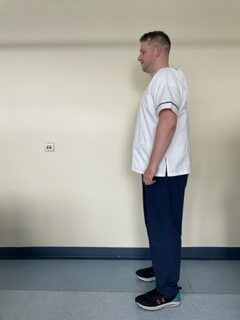

Why?
This exercise helps to strengthen your lower leg muscles as well as improving your balance when standing and walking. It will help with normal day to day activities like: standing up, reaching into high cupboards and balancing on your toes.
Exercise 2: Mini Squat
Stand with your feet shoulder width apart. Keep your head and chest upright, and spine in a neutral position. Slowly push your hips back and bend your knees. Complete 2 sets of 10 reps with each leg. When these start to become easier over time:
• Increase the number of sets to 3 and repetitions by 5 to 10 reps.
• Hold a small weight when completing the exercise.
• Hold the bottom position for 5 seconds.
If this is too hard:
• Do less repetitions.
• Hold onto a supportive surface when completing the exercise.
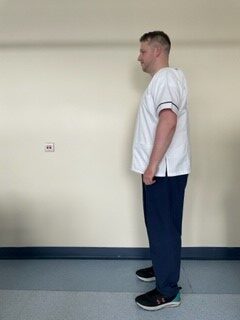

Why?
This exercise helps strengthen the muscles on the front and back of your leg. These muscles are key for keeping your legs strong enough to walk. It will help with normal day-to-day activities such as standing up, picking items up from the floor and reaching down into cupboards.
Exercise 3: Marching on the Spot
Standing shoulder width apart, bring one knee up towards your chest and place back onto the floor. Repeat with the other leg and alternate this. Complete 2 sets of 10 reps with each leg. When these start to become easier over time:
- Increase the number of sets to 3 and the repetitions by 5 to 10.
- Add a small ankle weight or resistance band around your thighs.
- March around the room.


Why?
This exercise helps strengthen your hips and knees muscles, and improve the flexibility and movement in your hip and knee joints. Increasing your flexibility in these joints can help with normal day to day activities like: walking up stairs, stepping over a curb and getting dressed.
Exercise 4: Standing Hip Abductions
Stand with your legs together, facing a supportive surface/wall. Place a hand on the surface/wall. Keeping both legs straight, raise one leg to the side then return to the starting position. Repeat this with the other leg and alternate. Complete 2 sets of 10 reps with each leg. When these start to become easier over time:
• Increase the number of sets to 3 and the repetitions by 5 to 10.
• Adding a small weight around your ankle if appropriate or add a resistance band around your thighs.
If this is too hard:
• Step to the side rather than lifting your foot above the ground.
• Place both hands on a supportive surface.


Why?
This exercise helps to strengthen your hip, thigh and buttock muscles. These muscles are important when you need to move your legs sideways, for normal day to day activities like: getting in and out of bed or a car and stepping sideways over an object or to reach something to the side of you.
Exercise 5: Standing Kickbacks
Stand with your legs together, facing a supportive surface/wall. Place a hand on the surface/wall. Keeping your leg straight, raise one leg back away from your body then return to the starting position. Repeat this with the other leg and alternate. Complete 2 sets of 10 reps with each leg. When these start to become easier over time:
• Increase the number of sets to 3 and the repetitions by 5 to 10
• Adding a small weight around your ankle if appropriate or add a resistance band around your thighs.
If this is too hard:
• Step back rather than lifting your foot above the ground
• Place both hands on a supportive surface.
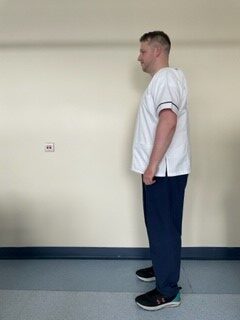

Why?
This exercise helps to strengthen your hip, leg and lower back muscles. These are the muscles you use to complete normal day-to-day activities like: standing up from a chair, walking and balancing on one foot.
Upper Limb Strengthening Exercises
Exercise 1: Hand Climbs
Stand facing a wall. Place both hands on the wall, shoulder width apart. Keeping your arms straight, walk your hands up the wall above your head and back down to shoulder height.
Complete 2 sets of 10 reps.
When these start to become easier over time:
• Increase the number of sets to 3 and the repetitions by 5 to 10.
If this is too hard:
• Keep your elbows slightly bent.
• Reduce the distance you walk your hands up the wall.
Why?
This exercise helps to strengthen your shoulder and arm muscles. This will help with normal day-to-day activities like: washing, dressing and reaching into cupboards.
Exercise 2: Wall Press Ups
Stand facing a wall. Place both hands on the wall and position your hands shoulder width apart with your fingers pointing up to the ceiling. Bend your elbows and bring your chest towards the wall. Straighten your arms to return to the starting position and repeat the exercise. Complete 2 sets of 10 reps. When these start to become easier over time:
- Increase the number of sets to 3 and the repetitions by 5 to 10.
- Hold for 5 seconds at the lowest position.
If this is too hard:
- Reduce the repetitions.
- Reduce the distance you bring your chest towards the wall.
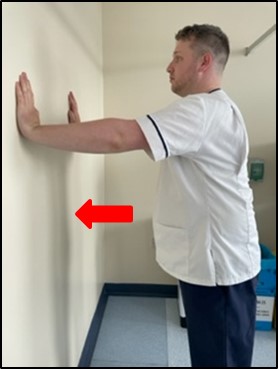
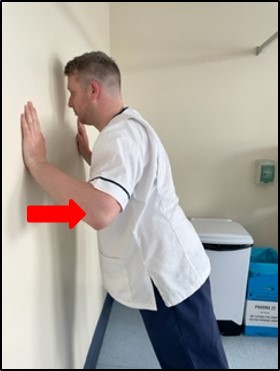
Why?
This exercise helps to strengthen your shoulder, chest and arm muscles. This will help with normal day-to-day activities like: dressing, opening doors, washing your hair and carrying objects.
Exercise 3: Full Moons
Standing upright, place your hands by your side with your palms facing towards your thighs. Keep your elbows slightly bent and raise your arms out to the side. Once in a horizontal position, turn your arm so that the palms of your hands are facing forward and continue to raise your hands above your head. Complete 2 sets of 10 reps. When these start to become easier over time:
• Increase the number of sets to 3 and the repetitions by 5 to 10.
• Hold a small weight in your hand while completing the exercise.
If this is too hard:
- Reduce the repetitions.
- Reduce the distance you raise your arms.
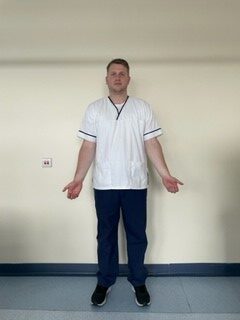
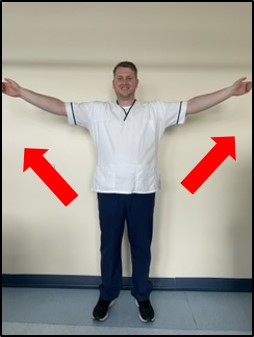
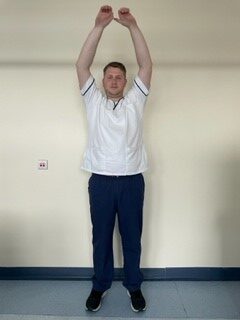
Why?
This exercise helps to strengthen your shoulders, arms and back muscles. This will help with normal day-to-day activities like: washing your hair, tying your hair up and reaching up into high cupboards.
Exercise 4: Bicep Curls
Standing upright, place your hands by your sides with your palms facing towards the front. Keep your elbows tucked into your sides; bend your elbows and bring your palms towards your face. Complete 2 sets of 10 reps. When these start to become easier over time:
• Increase the number of sets to 3 and the repetitions by 5 to 10.
• Hold a small weight in your hand while completing the exercise.
• Turn your palms into your thighs and do the same movement.
If this is too hard:
• Reduce the repetitions.
- Reduce the distance you raise your arms.
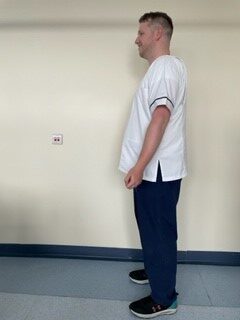
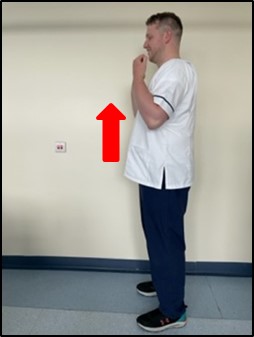
Why?
This exercise helps to strengthen your arm muscles. This will help with normal day-to-day activities like: having a drink, holding a kettle, eating and brushing your teeth.
Exercise 5: Wrist Curls
Standing upright, place hands by your sides with your palms facing towards the front. Keep your elbows tucked into your sides and bent to 90 degrees. Bend your hands up and down. Do 2 sets of 10 reps. When these start to become easier over time:
• Increase the number of sets to 3 and the repetitions by 5 to 10.
• Hold a small weight in your hand while completing the exercise.
If this is too hard:
• Reduce the repetitions.
• Wrest your arm on a supportive surface with your wrist hanging of the edge and complete the exercise.
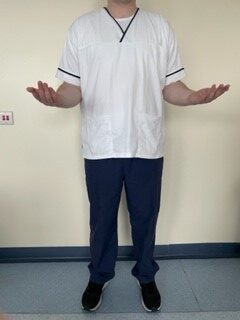
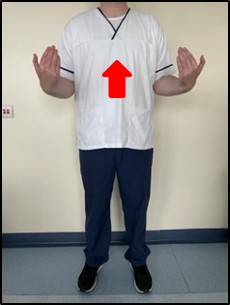
Why?
This exercise helps to strengthen your wrist and forearm muscles. This will help with normal day-to-day activities like: fastening zips, fastening buttons, holding a cup and carrying objects.
PIL1514 – Standing Exercises (250kB pdf)
What do I do if I have a fall?
Although increasing physical activity levels can reduce the risk of accidental falls and falls-related injuries, falls can still happen. If you have had a fall, lost your confidence or became unsteady on your feet, it is even more important that you stay active and complete your exercises daily (NHS inform, 2023).
If you do have a fall, the following information can help with remaining safe:
- Do not panic.
- Use a telephone, pendant alarm, or try to shout for help.
- Do not move if you feel any sort of pain or know that you have injured yourself.
- And you are not injured, you may want to try to get onto your hands and knees near the closest chair first before getting up.
- If you have tried to get up but are unable to, you need to keep warm. Try to keep your arms and legs moving regularly and cover yourself with anything close by.
- You should always tell your doctor and health care professionals; even if you were successful on getting yourself up following the fall and do not feel injured.
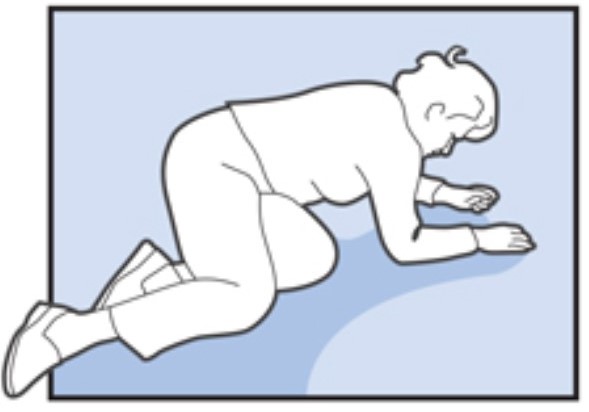
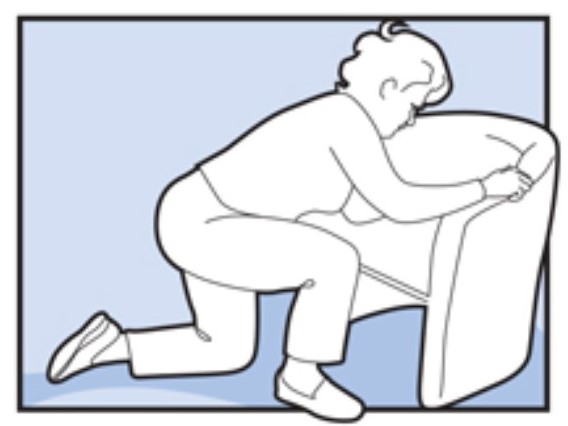
Reference List
- NHS Inform (2023) Keeping active to help prevent falls. Available at: https://www.nhsinform.scot/healthy-living/preventing-falls/keeping-well/keeping-active-to-help-prevent-falls (Accessed on: 18 May 2023).
- Alberta (2019) How to get up from the floor by yourself. Available at: https://myhealth.alberta.ca/Alberta/Pages/get-up-by-yourself-fall-prevention.aspx (Accessed on: 19 May 2023).
Comments, concerns, compliments or complaints
Patient Experience Team (PET)
We are continually trying to improve the services we provide. We want to know what we’re doing well or if there’s anything which we can improve, that’s why the Patient Experience Team (PET) is here to help. Our Team is here to try to resolve your concerns. The office is based at the University Hospital of North Tees if you wish to discuss concerns in person. Our contact details are:
Telephone: 01642 624719
Freephone: 0800 092 0084
Opening hours: Monday to Friday, 9:30am to 4:00pm
Email: [email protected]
Out of hours
Out of hours if you wish to speak to a senior member of Trust staff, please contact the hospital switchboard who will bleep the appropriate person.
Telephone: 01642 617617
Patient, Public and People with Lived Experience
We are looking for patients to share their experiences of healthcare and to join our Involvement Bank. Working with the patients, carers, families and the general population we support in making decisions about their care can lead to better health outcomes, increased patient satisfaction and a better overall experience. We want to listen and work with you in shaping the future of your healthcare services. To find out more about the Involvement Bank go to our website or contact us at:
Website: www.nth.nhs.uk/about/community/people-with-lived-experience
Email: [email protected]
Data protection and use of patient information
The Trust has developed Data Protection policies in accordance with Data Protection Legislation (UK General Data Protection Regulations and Data Protection Act 2018) and the Freedom of Information Act 2000. All of our staff respect these policies and confidentiality is adhered to at all times. If you require further information on how we process your information please see our Privacy Notices.
Telephone: 01642 383551
Email: [email protected]
Privacy NoticesLeaflet feedback
This leaflet has been produced in partnership with patients and carers. All patient leaflets are regularly reviewed, and any suggestions you have as to how it may be improved are extremely valuable. Please write to the Clinical Governance team at:
Email: [email protected]
Leaflet reference: PIL1514
Date for Review: July 2027